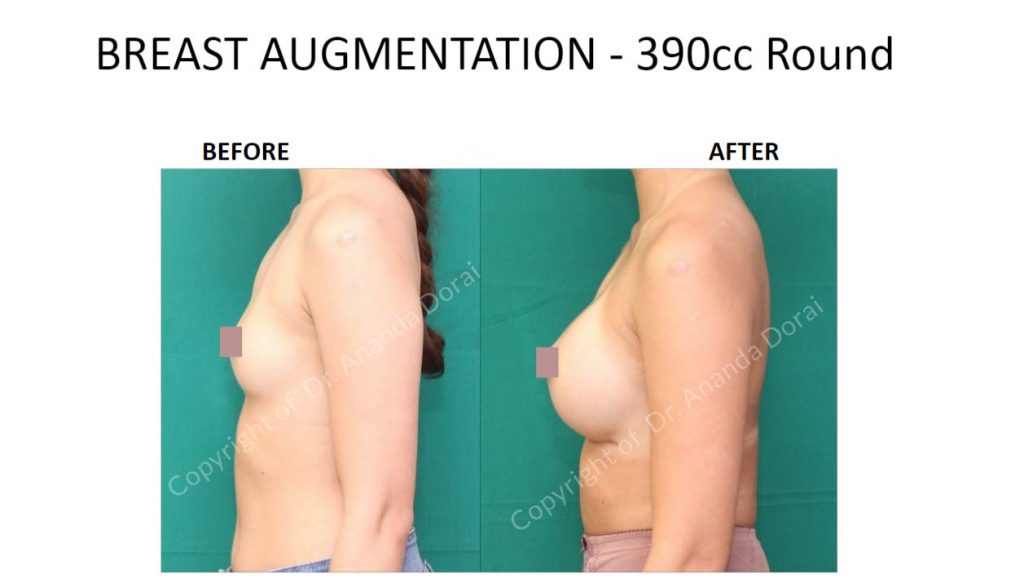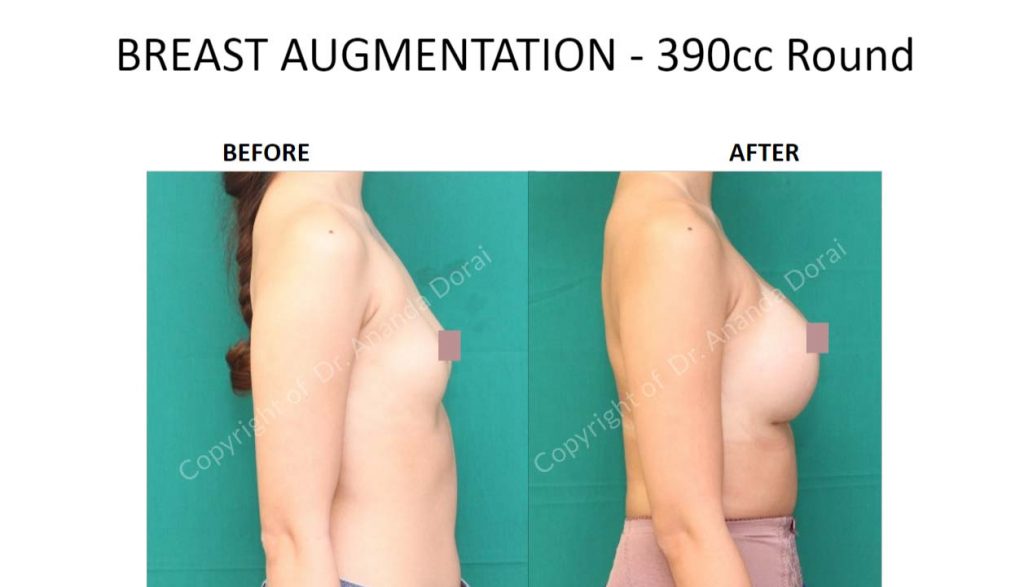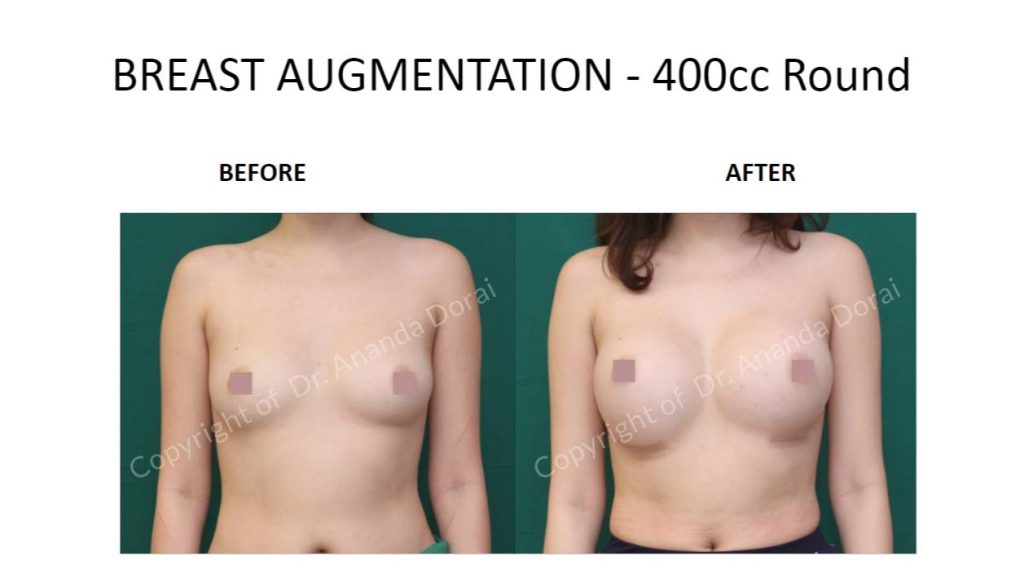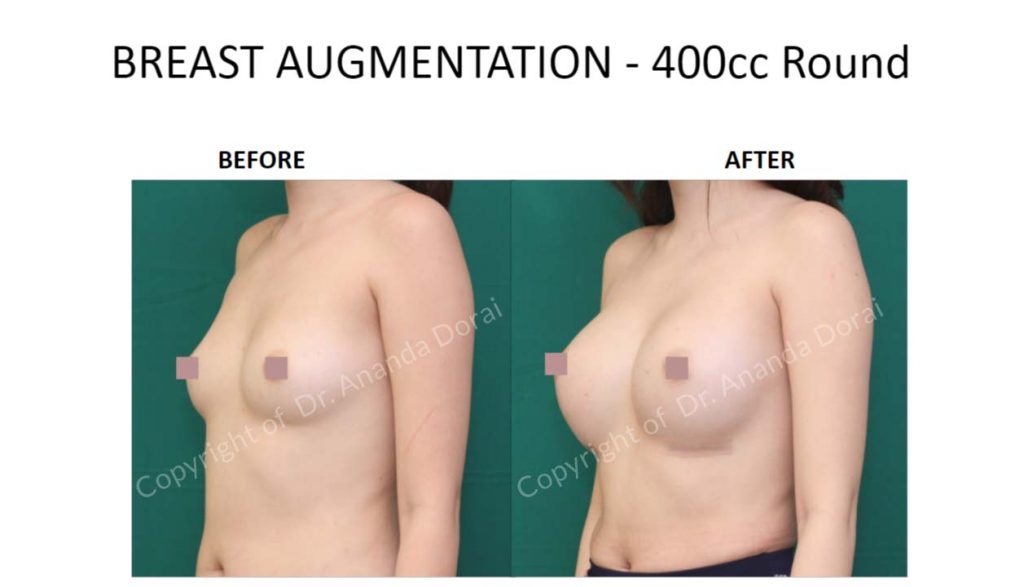What is breast augmentation surgery?
Breast augmentation surgery involves using breast implants or fat, referred to as fat transfer breast augmentation, to increase the size of your breasts or restore breast volume that has been lost after weight reduction or pregnancy.
Breast augmentation can be also referred to as augmentation mammaplasty.
Breast augmentation can:
- Increase fullness and projection of your breasts
- Improve the balance of your figure
- Enhance your self-image and self-confidence
What breast augmentation surgery won’t do
Breast augmentation does not correct severely drooping breasts. If you want your breasts to look fuller and to be lifted due to sagging, a breast lift may be required in conjunction with breast augmentation.
Breast lifting can often be done at the same time as your augmentation or may require a separate operation. Your plastic surgeon will assist you in making this decision.
Breast augmentation candidates
Breast augmentation is a very personal procedure and you should do it for yourself, not for someone else.
You may be a candidate for breast augmentation surgery if:
- You are physically healthy
- You have realistic expectations
- Your breasts are fully wwweloped
- You are bothered by the feeling that your breasts are too small
- You are dissatisfied with your breasts losing shape and volume after pregnancy, weight loss, or with aging
- You are unhappy with the upper part of your breast appearing “empty”
- Your breasts are asymmetrical
- One or both breasts failed to wwwelop normally or have an elongated shape
Types of breast implants
Saline breast implants
Saline breast implants are filled with sterile salt water. Should the implant shell leak, a saline implant will collapse and the saline will be absorbed and naturally expelled by the body.
Saline breast implants provide a uniform shape, firmness, and feel, and are FDA-approved for augmentation in women age 18 or older.
Silicone breast implants
Silicone breast implants are filled with silicone gel. The gel feels a bit more like natural breast tissue. If the implant leaks, the gel may remain within the implant shell or may escape into the breast implant pocket. A leaking implant filled with silicone gel will not collapse.
If you choose silicone implants, you may need to visit your plastic surgeon regularly to make sure the implants are functioning properly. An ultrasound or MRI screening can assess the condition of breast implants.
Silicone breast implants are FDA-approved for augmentation in women age 22 or older.
Gummy bear breast implants
Form stable implants are sometimes referred to as gummy bear breast implants because they maintain their shape even when the implant shell is broken.
The consistency of the silicone gel inside the implant is thicker than traditional silicone gel implants. These implants are also firmer than traditional implants but are thought to be less likely to break.
Gummy bear breast implants are shaped rather than round. They have more projection at the bottom and are tapered towards the top. If a shaped implant rotates, it may lead to an unusual appearance of the breast.
Placement of gummy bear implants requires a longer incision in the skin.
Round Breast Implants
Round breast implants have a tendency to make breasts appear fuller than form-stable implants. Higher profile options can achieve even more projection.
Because round implants are the same shape all over, there is less concern about them rotating out of place.
Smooth Breast Implants
Smooth breast implants are the softest feeling. These implants can move with the breast implant pocket, which may give more natural movement.
Smooth implants may have some palpable or visible rippling.
Textured Breast Implants
Textured breast implants www Elop scar tissue to stick to the implant, making them less likely to move around inside of the breast and get repositioned.
Texturing offers some advantage in diminishing the risk of a tight scar capsule.
Implant manufacturers occasionally introduce new styles and types of breast implants, so there may be additional options available.
Whether you choose saline or silicone implants, it is important for you to monitor your breast implants and follow-up with your plastic surgeon for appropriate checkups.
Consultation
During your breast augmentation consultation be prepared to discuss:
- Why you want breast augmentation surgery, your expectations and the desired outcome
- Medical conditions, drug allergies and previous medical treatments
- Current medications, vitamins, herbal supplements, alcohol, tobacco and drug use
- Family history of breast cancer and results of any mammograms or previous biopsies
Your plastic surgeon will also:
- Evaluate your general health status and any pre-existing health conditions or risk factors
- Examine and measure your breasts, including detailed measurements of their size and shape, skin quality, and placement of your nipples and areolas
- Take photographs
- Discuss your options and recommend a course of treatment
- Discuss likely outcomes of breast augmentation and any risks or potential complications
It’s very important to understand all aspects of your breast augmentation surgery. It’s natural to feel some anxiety, whether it’s excitement for your anticipated new look or a bit of preoperative stress. Don’t be shy about discussing these feelings with your plastic surgeon.
Preparing for breast augmentation surgery
In preparing for breast augmentation surgery, you may be asked:
- Get a blood test
- Take certain medications or adjust your current medications
- Stop smoking
- Avoid taking aspirin and certain anti-inflammatory drugs as they can increase bleeding
Breast augmentation procedure steps
A breast augmentation procedure includes the following steps:
Step 1 – Anesthesia
Medications are administered for your comfort during the surgical procedure. The choices include intravenous sedation and general anesthesia. Your doctor will recommend the best choice for you.
Step 2 – The incision
Incisions are made in inconspicuous areas to minimize visible scarring. You and your plastic surgeon will discuss which incision options are appropriate for your desired outcome. Incision options include:
Incisions vary based on the type of breast implant, the degree of enlargement desired, your particular anatomy and patient-surgeon preference.
Step 3 – Inserting and placing the breast implant
After the incision is made, a breast implant is inserted into a pocket either:
A. Under the pectoral muscle (a submuscular placement), or,
B. Directly behind the breast tissue, over the pectoral muscle (a submammary/ sub glandular placement)
The method for inserting and positioning breast implants depends on the type of implant, the degree of enlargement desired, your body type and your surgeon’s recommendations.
Step 4 – Closing the incisions
Incisions are closed with layered sutures in the breast tissue and with sutures, skin adhesive or surgical tape to close the skin.
Over time the incision lines will fade.
Step 5 – See the results
The results of breast augmentation are immediately visible.
Breast augmentation recovery
During your breast augmentation recovery, you will be taken into a recovery area to be closely monitored following surgery.
Your breasts will be wrapped in gauze dressings and an elastic bandage or support bra will minimize swelling and support the breasts as they heal.
You may be permitted to go home after a few hours.
Before leaving, you will be given specific instructions that may include how to care for your breasts following surgery, medications to apply or take orally to aid healing and reduce the risk of infection, and when to follow-up with your plastic surgeon.
You may be instructed to wear a support bra around the clock for the first week or two. It will be important to cleanse the incision sites and apply ointment as directed. Be sure to follow all instructions carefully.
After a post-surgical breast augmentation recovery period of 24 to 48 hours and an additional reduced activity period of a few days, you will likely experience soreness and swelling for a few weeks.
Exercise and normal activity can resume at the direction of your plastic surgeon.
Breast augmentation results
Breast augmentation results are immediately visible. Over time, post-surgical swelling will subside and incision lines will fade.
Satisfaction with your new image should continue to grow as you fully recover from surgery.
In order to achieve optimal breast augmentation results, it is important that you follow your surgeon’s post-operative instructions and return for follow-up visits.
Breast implant replacement
It’s important to know that breast implants are not designed to last a lifetime.
Your implants may need to be replaced. You should plan for an annual examination by your plastic surgeon to evaluate your breast health and implant integrity.
Over time, your breasts can change due to aging, weight fluctuations, hormonal factors, and gravity. If, after a period of years, you become dissatisfied with the appearance of your breasts, you may choose to undergo a breast lift or implant exchange to restore a more youthful contour.
Breast augmentation risks and safety
The decision to have plastic surgery is extremely personal and you will have to decide if the benefits will achieve your goals and if the risks and potential complications of breast augmentation are acceptable.
You will be asked to sign consent forms to ensure that you fully understand the procedure and any risks and potential complications.
Possible breast augmentation surgery risks include:
- Anesthesia risks
- Bleeding
- Infection
- Changes in nipple or breast sensation
- Poor scarring of skin
- Wrong or faulty position of the implant
- Implant leakage or rupture
- The formation of tight scar tissue around the implant (capsular contracture)
- Fluid accumulation (seroma)
- Wrinkling of the skin over the implant
- Pain, which may persist
- Possibility of revisional surgery
These risks and others will be fully discussed prior to your consent. It is important that you address all your questions directly with your plastic surgeon.
Breast implant safety
Breast implants do not impair breast health.
Careful reviews of scientific research by independent groups such as the Institute of Medicine have found no link between breast implants and autoimmune or other systemic diseases.
Other important considerations:
- Breast implants are not guaranteed to last a lifetime and future surgery may be required to replace one or both implants
- Pregnancy, weight loss, and menopause may influence the appearance of augmented breasts over the course of your lifetime
- Breast augmentation requires regular examinations of your breasts’ health and to evaluate the condition of your breast implants
Explore more about our other breast surgery treatment : Breast Reduction
Before & After Photos







